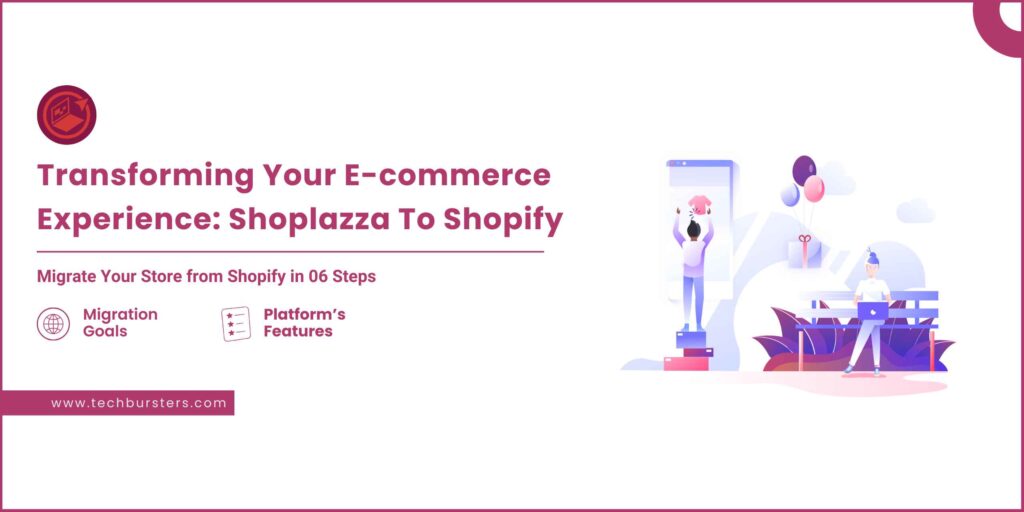
As your business grows, it’s expected to make crucial changes to accommodate this development. You might need a bigger office or warehouse, more employees, or more sophisticated software. Furthermore, when your e-commerce website attains a level of success, you’ll need to migrate to a bigger platform like Shopify.
E-commerce giant Shopify accounts for 10% of the global e-commerce software industry. It’s no surprise that multinational brands like Netflix and Fashion Nova have made a name for themselves on this platform. Migrating to e-commerce platforms like Shopify is how you outwit your competitors, retain loyal customers, and gain more clients.
Replatforming can significantly transform the ecommerce experience for you and your customers. If you’re currently on the Shoplazza platform and intend to transition to Shopify, here’s all you need to know and how to do it.
Considerations for Shoplazza to Shopify Migration
Your Shoplazza to Shopify migration attempt might be your best business decision yet. However, the implications are enormous, so you must carefully consider these crucial factors.
1. Your Business Migration Goals
Before migrating to a new platform, clearly define your business goals. Know what you want to achieve within a certain time frame and set realistic expectations. It will guide you in choosing the right e-commerce website for your business growth.
2. The New Platform’s Features
While defining your migration goals, do some digging into your e-commerce website options. See which platform can help you achieve these goals. You’ll find out by research. Check and compare their features to see what advantages they can provide.
Make sure their features make up for what your previous platform lacks. For instance, the new platform might allow you to add more sales channels than your current one. When you find a platform that helps you achieve your goals, start working toward re-platforming.
3. Your Budget
You don’t want to venture into a massive undertaking like website migration only to stop halfway. One of the common causes of a failed migration can be insufficient funds. Critical factors like performance testing and monitoring, technician pay, and new platform size determine the cost of the procedure.
Prepare a budget and let it guide you to spend purposefully and cut costs wherever necessary. That way, you will have enough money left to run your business.
4. Current IT Infrastructure and Staff Strength
Moving to a major website like Shopify can be tricky. You’ll need all the help you can get from your current workforce. Consider your physical and human resources, from CRM software to customer support teams. You may upgrade your tools or retrain your staff to meet the demands of a major platform.
Good to Read:- Migrating From Sitecore To WordPress: A Step-by-Step Guide
How to Migrate from Shoplazza to Shopify?
Transferring your website data from Shoplazza to Shopify can be seamless if you know the right steps. Here’s how to migrate without hassle.
1. Learn the New Platform’s Terms and Conditions
The first thing to do when migrating to a new e-commerce website is to learn about its terms of use. Every web platform has guidelines for merchants and users to ensure ethical and legal use of the platform.
For instance, Shopify states its rules for payment of fees, account activation and termination, and taxes, among others on its platform. Learning these terms can keep you from legal issues and enjoy success on the platform.
2. Set Up Your New Space
Designing your e-commerce space is how you secure it and make it stand out from other stores on Shopify. This phase will involve the front-end and back-end programming. This is where you’ll set up your account password, payment and shipping methods, and blogging parameters. Make sure you test the SEO functionality to ensure that customers can find you on search engines.
In addition, customize the checkout features to create the best e-commerce experience for customers.
3. Transfer Your Data
After designing your online store and setting the business account parameters, you can now move in your data. Website data transfer is a risky procedure that can result in data loss. A glitch in the transfer process may sabotage the entire process.
Ensure to back up all your files from the old site before the data extraction and transfer. You may hire a tech expert or use data transfer software for this operation.
4. Test the Site’s Functionality
Before launching your new e-commerce site, you would like to confirm it works perfectly. Running multiple tests is the way to go. Check the site navigation, see how it displays on phone screens, and experience the checkout procedure from an outsider’s perspective.
Chrome DevTools Coverage, Google Lighthouse, and Google Search Console are technological tools to help you perform website performance tests. That way, you’ll know your site is running as expected.
5. Launch your Shopify Store
Opening your Shopify store is the fun part. However, you’ll need to create buzz around it to make existing and potential customers aware. You may run a limited social media campaign or get help from influencers to announce the launch date. Besides creating awareness, the launching aims to convert attendees into customers.
6. Promote the Store
Promotion is necessary to reach as many people as possible. Shopify has various promotional features that can help you spread the word across. Add sales channels to your store. From social media to traditional marketplaces, you create limitless paths to interact with new customers.
Good to Read:- What Makes Shopify Plus Stand Out from Regular Shopify?
Begin the Transformation Today
Replatforming might be the best decision for your business if you want to expand and reach more customers. It’s a lengthy process that starts with understanding the conditions surrounding this endeavor. You’ll then follow the crucial steps to completing the website migration process.
Finally, promote your website and continually test it for bugs and security breaches. There’s no better time than now to re-platform your e-commerce website. Transform your eCommerce experience today.
